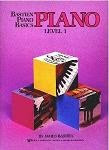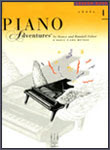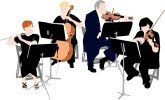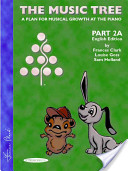UPDATED REVIEW: August 1, 2019 – General MIDI (aka: MIDI) songs are FUN & Educational! Practicing or playing piano with live or pre-recorded accompaniments makes music more fun, more interesting, and allows for the student or player an opportunity to understand and comprehend piano playing in a way that speeds up the learning process. It’s like playing along with the orchestra or band but at your own speed and doing it with your lesson books!*
I am a long time piano teacher and pro musician and play a variety of musical instruments. I really enjoy playing music and it has been my passion since I was very young. When it comes to piano, ultimately, the more exciting the piano playing experience is, the more motivated and likely the student and player is to learn, to practice, and to improve. And when the pianist and/or student gets a chance to play piano with a full live orchestra or band, that experience is even better, in my opinion! When I get to personally play along with an orchestra or contemporary band accompaniment, it is very inspiring and I also become a better player and it helps me to want to keep practicing. But most piano players and piano students don’t have an orchestra or band available in their home or studio to play along with so that’s where MIDI songs come in:)
 MIDI (pronounced “middy” with emphasis on the short “i”) songs are pre-recorded digital accompaniments in the form of note data, (not traditional audio recordings) which play “live” music (without the vocals) on certain types of digital keyboards, digital pianos, and computers. MIDI stands for “musical instrument digital interface” and it is a standardized technology using a USB cable from a digital piano with a USB output (preferred) or the more standard MIDI inputs & outputs to connect computers or sound modules with a MIDI cable (pictured above left) to the back of a MIDI digital instrument (left). Actually, MIDI connections are fading away in favor of better USB connections because of the new USB iPad connectivity becoming so popular.
MIDI (pronounced “middy” with emphasis on the short “i”) songs are pre-recorded digital accompaniments in the form of note data, (not traditional audio recordings) which play “live” music (without the vocals) on certain types of digital keyboards, digital pianos, and computers. MIDI stands for “musical instrument digital interface” and it is a standardized technology using a USB cable from a digital piano with a USB output (preferred) or the more standard MIDI inputs & outputs to connect computers or sound modules with a MIDI cable (pictured above left) to the back of a MIDI digital instrument (left). Actually, MIDI connections are fading away in favor of better USB connections because of the new USB iPad connectivity becoming so popular.
 “General MIDI ” (aka: GM) is a standardized format of instrument sounds & effects that refers to the playing of actual songs in a General MIDI or multi-instrument MIDI equipped digital piano. When your computer is playing music through a program like a game, etc, that music is using the General MIDI multi-instrument format from your computer soundcard which is located inside your computer. General MIDI was developed in the early ’90’s and is available in various brands and models of new digital pianos. This song format is designed to play up to 16 separate instrument parts including percussion (from a general menu of up to 128 instrument sounds or more) which can play simultaneously on an General MIDI equipped digital instrument or device that can take a digital memory device like a USB flashdrive. This gives the piano the ability to playback & record big orchestral, rhythmic, and other styles of music.
“General MIDI ” (aka: GM) is a standardized format of instrument sounds & effects that refers to the playing of actual songs in a General MIDI or multi-instrument MIDI equipped digital piano. When your computer is playing music through a program like a game, etc, that music is using the General MIDI multi-instrument format from your computer soundcard which is located inside your computer. General MIDI was developed in the early ’90’s and is available in various brands and models of new digital pianos. This song format is designed to play up to 16 separate instrument parts including percussion (from a general menu of up to 128 instrument sounds or more) which can play simultaneously on an General MIDI equipped digital instrument or device that can take a digital memory device like a USB flashdrive. This gives the piano the ability to playback & record big orchestral, rhythmic, and other styles of music.
Just about any song, composer, or band you can think of has their music in a General MIDI format. Thousands upon thousands of songs in every style and era are available including Classical Beethoven & Bach, Beatles, Frank Sinatra, Stevie Wonder, Carrie Underwood, Duke Ellington, Ray Charles, Michael Buble, Kelly Clarkson, Celine, Big Band, Swing, R&B, Latin, Rock, Christian, Broadway, Waltz, Movie themes, Disney, Children’s music, current pop, jazz, blues, Latin, you name it and you can probably get it!
The MIDI songs can be downloaded from on-line MIDI song web sites for about $1-$5 each, and there are also web sites that provide free MIDI songs although they may not sound as good. The more authentic & professional sounding the song is, the more money it typically will cost. Piano students can purchase entire lesson book MIDI song accompaniments as well.
For years the MIDI songs were available on floppy disk, but since that format is now extinct, USB flash drives (left pic) have pretty much taken over as storage memory devices for digital pianos. There are certain digital pianos (with the General MIDI format) made to accept these new kinds of devices so that MIDI songs can be played, recorded, and saved. Generally speaking these MIDI playback & recording digital pianos with authentic piano touch & tone have been very expensive starting at $3000 on up, so few people wanted to spend that kind of money, but that is changing now due to some lower prices. I have used MIDI song files for years on various digital pianos and I really like them. Some of the songs are so professionally done that they sound like the original recordings. If you haven’t heard General MIDI songs before, you will be amazed at how exciting & authentic they really are! By the way, you don’t need MIDI connections or cables to play or record General MIDI songs; just the right digital piano that is already set up for General MIDI with USB flashdrive input.

 What makes MIDI songs unique (as opposed to CD’s & MP3 files), is that they can be played directly on a home (or pro) digital piano designed with that GM function giving the player the ability to adjust song speed for slower or faster playback, which is important for proper learning. The digital piano also allows for adjustment in volume and balance between the accompaniment and the live piano part being played by the student or player. The most exciting use for General MIDI songs is to enable the piano student to have a more satisfying piano practice experience in their home while learning to play piano in ways that can make them a much better player with a greater understanding of music & rhythm. A few of the major piano curriculum & lesson books published these days are available with MIDI songs including Faber Adventure series and Alfred. The top piano instruction publishers have jumped into this format because they know how motivating and useful it is.
What makes MIDI songs unique (as opposed to CD’s & MP3 files), is that they can be played directly on a home (or pro) digital piano designed with that GM function giving the player the ability to adjust song speed for slower or faster playback, which is important for proper learning. The digital piano also allows for adjustment in volume and balance between the accompaniment and the live piano part being played by the student or player. The most exciting use for General MIDI songs is to enable the piano student to have a more satisfying piano practice experience in their home while learning to play piano in ways that can make them a much better player with a greater understanding of music & rhythm. A few of the major piano curriculum & lesson books published these days are available with MIDI songs including Faber Adventure series and Alfred. The top piano instruction publishers have jumped into this format because they know how motivating and useful it is.
If you are not currently using General MIDI songs in your lessons and/or at home for lessons or just playing along with your favorite songs, then you should consider it and ask me more about them including getting you info on the variety of digital pianos that have this feature. If you are a piano teacher and haven’t used the General MIDI song format before, then you should definitely try it like so many other piano teachers have and now use it in their studios to enhance their lesson program. As far as a proper digital piano that will have realistic piano tone, key touch, and great General MIDI device input for a low price, one of the newer pianos in a lower price range I would recommend you consider is the Casio PX780 Privia furniture cabinet piano. It is internet priced at $999 (incl stand & 3 pedals) and is an amazing instrument in its lower price range with a realistic acoustic piano tone and a surprisingly piano graded hammer key touch movement.
Go to the following link if you want more info on the Casio PX780: Casio PX780 Review. You would have the best of both worlds with an excellent piano that would enable you to play your practice pieces to full accompaniments using your General MIDI songs. The Casio PX780 piano uses a regular USB flash drive for song storage and playback and the system is easy to use. There are other good General MIDI furniture cabinet pianos from brands such as Yamaha, Kawai, & Roland at over $2000 up well above $5000 as well.
The thing that most every piano student really wants is to have fun and be motivated to play their piano at home as well as looking forward to their practice time. In my opinion, General MIDI songs help make that a reality. Unfortunately, many piano teachers are set in their ways and do not understand or want to understand General MIDI songs and how they can be a positive part of the teaching and lesson curriculum. But if it didn’t work, then the most popular piano method books wouldn’t produce them.
So do yourself a favor; if you’re a piano student and/or a pianist, and you don’t already have a General MIDI multi-instrument digital piano with full song playback and/or recording capabilities, then consider getting one, even if you already have a regular acoustic piano. It can be worth the investment in your musical future, and there’s nothing more exciting to me than to see a piano student or recreational player excel at their playing while being motivated to play often:).
For more info on General MIDI song lesson practice & play-along and how it all works, or if you want to purchase one of these new General MIDI capable digital pianos for less then internet pricing, please contact me at tim@azpianowholesale.com or call direct at 602-571-1864





















I really enjoyed the article on how to learn to play piano using Midi Songs. I have found this to be a very good way to learn piano. Being able to play along with songs I think really helps you understand what you are doing. It make learning easy and fun.
I used midi songs before, when my first time in learning how to play piano. it is really helpful!
Nice post frend..
i want to share.. how to learn piano! i think you must try this,, Thanks 🙂
http://qzmart.tk/
Sage advice, fantastic article, thanks. i hope you don't mind if i put a link to it at some point in my blog i think it's fantastic.
This is all great information. But the one question you did not answer of mine was, How would I get a song onto my SD Card to be able to play it on my casio?
Hi Tim – good article. Can I post details here about our MIDI Files? We are including 'Piano Arrangement' MIDI's to our full production range. They might be a good source for your students and followers to check out. Cheers, Amelie – Hit Trax MIDI Files. (PS: All our MIDI Files are fully licensed and royalty paid 👍 )